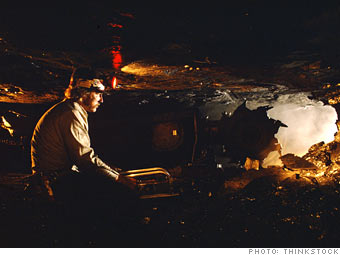
The biggest coal mining disaster in 40 years sent fatality rates soaring in 2010.
Fatality rate per 100,000 workers: 39
Median wage: $39,950
Last year, was not a good one for coal miners and, even more specifically, those who operated mining machinery.
An April explosion at the Upper Big Branch Mine in West Virginia killed 29 of the 31 miners working at the site, making it the U.S.'s worst coal mining disaster in 40 years, according to Phil Smith of the United Mine Workers of America.
As a result of the Upper Big Branch disaster and other accidents over the course of the year, mining fatalities rose 74% in 2010 to 172 deaths. Mining machinery operators suffered 23 deaths in 2010, causing a steep fatality rate.
Working in a coal mine is inherently dangerous. Methane gas trapped in coal seams escapes into tunnels and mine shafts -- miners can even hear it hissing. In a confined space, an explosion can injure workers many yards away. Or worse, cause a cave-in that buries or traps miners.
Luckily, however, coal mining fatalities are far lower than what they were decades ago when thousands of miners would sometimes die over the course of one year. That was when far more miners were employed, of course, but also when safety regulations and training were far less stringent.
"The focus on safety and enforcement of rules has gotten much better," said Smith. "Most companies recognize that they need to operate safely and that's progress."
NEXT: Roofer